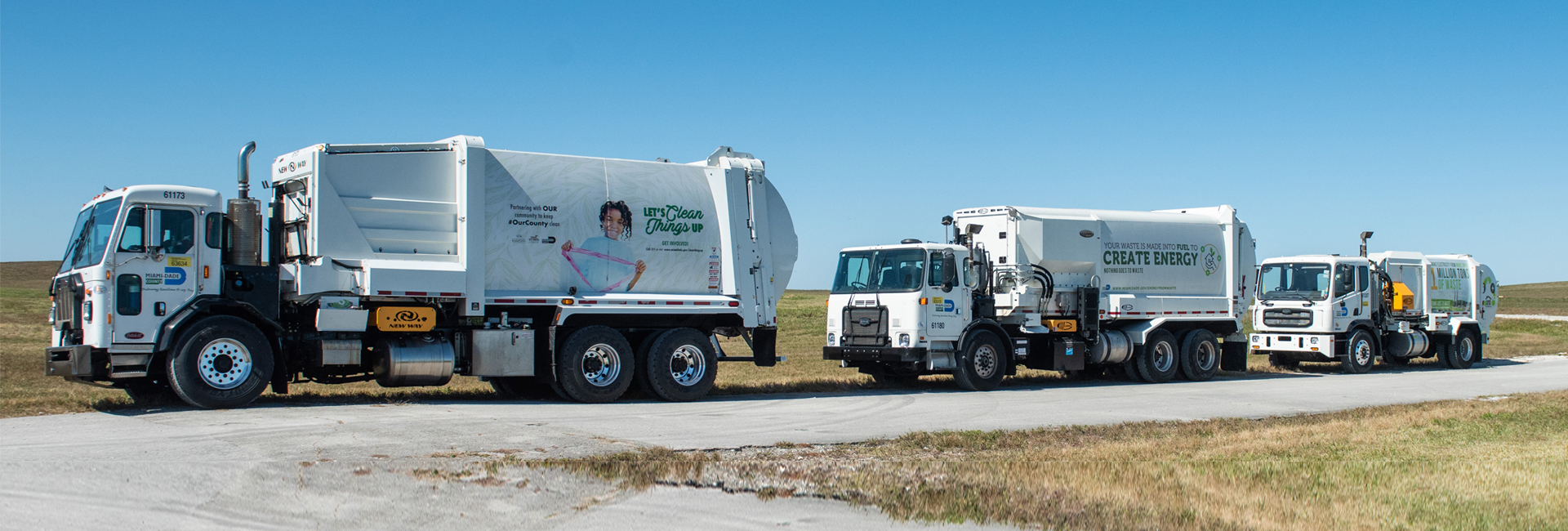Two landfills are available for permitted private haulers, municipal waste haulers and permitted landscapers.
Reflective vests are required and are available at the landfills for a fee. Hard hats, safety glasses and closed-toed/steel-toed shoes or boots are strongly recommended as the facilities are active landfill sites.
-
- Anyone disposing of anything at a landfill must wear a reflective safety vest at all times. Hard hats, safety glasses and closed-toed/steel-toed shoes or boots are strongly recommended
- No one will be allowed to enter the landfill without a reflective safety vest
-
This Class III (trash only) landfill is located just south of the Dade-Broward line, between NW 47th and NW 57th Avenues. The North Dade Trash and Recycling Center is also located at the site.
Waste haulers can deliver trash material like old furniture, lumber, crates, off-road tires (48 inches in diameter or larger), cardboard boxes and yard trash, along with construction and demolition debris.
At the scale house, vehicles are weighed entering and leaving the facility. The difference in weight helps determine the cost of the waste disposal.
The landfill has 2 cells, an eastern and a western cell. Only the eastern cell is currently accepting trash. The western cell is closed, but under continuous environmental monitoring.
Trash is compacted using a large bulldozer (compacter) with spiked wheels that drives over waste to reduce its volume. As required by law, clean cover material is spread over the compacted trash each week. This helps control odors, as well as reduce the number of birds that forage for food.
The eastern cell includes a leachate collection system and a groundwater monitoring system. Leachate is a liquid formed by rainwater percolating through waste at the landfill. Landfill leachate is processed through the sanitary sewer system.
Currently, methane gas resulting from the decomposition of the landfill's waste is extracted and flared. This will be replaced by a landfill gas-to-energy conversion system to be constructed.
Key Facts
- The 100-acre eastern cell is active and has a permitted height of 138 feet.
- The 118-acre western cell is closed and has a permitted height of 95 feet.
- The landfill began operating in 1951.
- The landfill was formerly a Class I landfill, becoming a Class III landfill in 1983.
-
County, municipal and private waste haulers can bring a variety of waste, including garbage, off-road and automobile tires, animal carcasses, trash and yard trash, construction and demolition debris and asbestos to the landfill.
Asbestos disposal requires authorization from the Department of Regulatory and Economic Resources (305-372-6925) and prior arrangement with the landfill (305-258-2830) 24 hours in advance. More information on asbestos.
This Class I (garbage) landfill is located in southeast Miami-Dade County, adjacent to the South District Wastewater Treatment Plant, Black Point Marina and Biscayne Bay. The South Dade Home Chemical Collection Center is co-located at the site.
The 300-acre landfill has 5 cells; 3 cells have already been filled and closed. The fourth cell is the active cell, and construction of the fifth cell is underway. Disposal capacity at the facility is anticipated to last through 2029.
At the on-site transfer operation, waste is unloaded on the tipping floor, a special area where waste is sorted. Some of this waste will be buried at the landfill, while most is typically loaded into 85-cubic yard transfer vehicles for transport to the Resources Recovery Facility, where waste is turned into energy.
Waste that will be buried at the landfill is taken to an active cell. It is deposited, and then compacted, so that it takes up the smallest space possible. At the end of each working day, the compacted waste is covered with soil or unders (tiny particles such as soil, rock, grit and broken glass that cannot be processed at the Resources Recovery Facility).
The landfill has been designed using the latest technology, with a synthetic liner system, leachate collection system and groundwater monitoring and treatment system. A sequencing batch reactor - industrial processing tanks for the treatment of wastewater - is used to treat leachate generated on site before it is pumped to the adjacent waste water treatment facility.
When a cell reaches capacity, it is closed following federal and state regulations. Closure activities include the installation of a final cover system that contains geosynthetic materials and soil layers, storm water drainage, landfill gas collection and associated piping.
A byproduct of decomposing waste is landfill gas, which is typically made up of about 50 percent methane gas, about 50 percent carbon dioxide and other trace substances. The landfill's closed cells include a series of wells to extract this gas. The gas is burned off at a flare located at the northern end of the landfill.
A gas-to-energy recovery facility is being constructed at the neighboring wastewater treatment facility. Landfill gas will be piped to the recovery facility where it will be combined with gas from the wastewater treatment facility. The combined gases will be converted into electricity to power operations at the wastewater treatment plant.
The landfill is also one of several sites in the disposal system that has been converted into a natural habitat and wetland area for native plants and varied wildlife. South Dade's 54 acres of restored wetlands are home to dozens of species of plants and wildlife, including the American alligator and bald eagle.
Key Facts
- The 50-acre Cell 4 is active.
- The landfill has a permitted height of 150 feet.
- Closed Cells 1 and 2 combined are about 60 acres, and Cell 3 is 50 acres.
- Cell 5 has 50 acres available for future disposal.
- Construction on the facility began in early 1978 and the first waste was landfilled in 1979.
- The original facility included a shredding plant that opened in 1981 and later closed when advances in landfill equipment improved landfill operations.
-
Learn more about our Disposal Fees.
Phone Number(s)
Locations and Hours
-
21500 NW 47th Ave, Miami, FL. 33055
- Monday
- 7:00 a.m. - 5:00 p.m.
- Tuesday
- 7:00 a.m. - 5:00 p.m.
- Wednesday
- 7:00 a.m. - 5:00 p.m.
- Thursday
- 7:00 a.m. - 5:00 p.m.
- Friday
- 7:00 a.m. - 5:00 p.m.
- Saturday
- 7:00 a.m. - 5:00 p.m.
- Sunday
- 7:00 a.m. - 5:00 p.m.
-
23707 SW 97th Ave, Homestead, FL. 33032
Gate A
- Monday
- 7:00 a.m. - 5:00 p.m.
- Tuesday
- 7:00 a.m. - 5:00 p.m.
- Wednesday
- 7:00 a.m. - 5:00 p.m.
- Thursday
- 7:00 a.m. - 5:00 p.m.
- Friday
- 7:00 a.m. - 5:00 p.m.
- Saturday
- 7:00 a.m. - 5:00 p.m.
- Sunday
- 7:00 a.m. - 5:00 p.m.
All Landfills Locations
-
Monday7:00 a.m. - 5:00 p.m.Tuesday7:00 a.m. - 5:00 p.m.Wednesday7:00 a.m. - 5:00 p.m.Thursday7:00 a.m. - 5:00 p.m.Friday7:00 a.m. - 5:00 p.m.Saturday7:00 a.m. - 5:00 p.m.Sunday7:00 a.m. - 5:00 p.m. -
Gate A
Monday7:00 a.m. - 5:00 p.m.Tuesday7:00 a.m. - 5:00 p.m.Wednesday7:00 a.m. - 5:00 p.m.Thursday7:00 a.m. - 5:00 p.m.Friday7:00 a.m. - 5:00 p.m.Saturday7:00 a.m. - 5:00 p.m.Sunday7:00 a.m. - 5:00 p.m.
Related Services

Solid Waste Management
Aneisha Daniel, PhD, DirectorDr. Martin Luther King Office Plaza
2525 NW 62nd Street,
5th Floor
Miami, FL 33147
305-514-6666 | [email protected]

